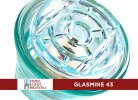Brancoli Memory Museum: GLASMINE 43
We want to present in this column some objects present inside the Brancoli Memory Museum, so that we know more about objects that for better or worse have made history together with the people who used them.
All these objects we present to you will be displayed in specific contexts in the new museum area we are working on.
We're going to introduce you to one of the various types of landmines present inside the Memory Museum of Brancoli, an ′′ anti-personnel mine ′′ which is among those called ′′ fragmentation ′′ or the activation of which produces an explosion in many fragments of which it is composed.
The mine you can see in the image is called ′′ Glasmine 43 ", the ′′ glass mine ", the description underneath makes you reflect on the dangerousness of this device, both harmless to appearance and actually bloody dangerous. Number 43 is precisely for the year of its production.
Glasmine 43 was an anti-man mine with a glass body used by the Germans during World War II; it consisted of a glass ′′ receptacle ′′ that contained an explosive charge and detonator. Later models were made with chemical fuses and wooden components.
A small amount of concrete mastice was applied to the mine's ′′ receptacle ′′ to seal the spaces between the main body and the glass disc cover to make it waterproof.
A 8-10 kg pressure or a person's step on the glass cap was enough to activate the detonator by exploding the explosive charge of the mine.
You may wonder, why produce a glass mine?
The use of glass material and the minimal amount of metal it was composed made it difficult to detect from the time detectors of the Allied forces, although it was buried only 2-3 cm above the ground so it was particularly insidious.
Glasmine was particularly used in coastal areas and wetlands, as glass guaranteed a high level of waterproofing
The Germans had even converted some glass supplements factories to produce this mine
Glasmine in its intent often wounded severely, but it didn't kill, so it carried other soldiers forced to recover the wounded companion from the camp. Glass fragments were difficult to detect even from X-rays, making it more difficult for medical intervention to lead to an increased risk of infection.
It's incredible to think how far many people's capabilities and genius were applied in producing objects that hurt people so much, instead of being able to use them to create solutions that could bring peace!
Photo: Object in the Brancoli Memory Museum.

We want to present in this column some objects present inside the Brancoli Memory Museum, so that we know more about objects that for better or worse have made history together with the people who used them.
All these objects we present to you will be displayed in specific contexts in the new museum area we are working on.
We're going to introduce you to one of the various types of landmines present inside the Memory Museum of Brancoli, an ′′ anti-personnel mine ′′ which is among those called ′′ fragmentation ′′ or the activation of which produces an explosion in many fragments of which it is composed.
The mine you can see in the image is called ′′ Glasmine 43 ", the ′′ glass mine ", the description underneath makes you reflect on the dangerousness of this device, both harmless to appearance and actually bloody dangerous. Number 43 is precisely for the year of its production.
Glasmine 43 was an anti-man mine with a glass body used by the Germans during World War II; it consisted of a glass ′′ receptacle ′′ that contained an explosive charge and detonator. Later models were made with chemical fuses and wooden components.
A small amount of concrete mastice was applied to the mine's ′′ receptacle ′′ to seal the spaces between the main body and the glass disc cover to make it waterproof.
A 8-10 kg pressure or a person's step on the glass cap was enough to activate the detonator by exploding the explosive charge of the mine.
You may wonder, why produce a glass mine?
The use of glass material and the minimal amount of metal it was composed made it difficult to detect from the time detectors of the Allied forces, although it was buried only 2-3 cm above the ground so it was particularly insidious.
Glasmine was particularly used in coastal areas and wetlands, as glass guaranteed a high level of waterproofing
The Germans had even converted some glass supplements factories to produce this mine
Glasmine in its intent often wounded severely, but it didn't kill, so it carried other soldiers forced to recover the wounded companion from the camp. Glass fragments were difficult to detect even from X-rays, making it more difficult for medical intervention to lead to an increased risk of infection.
It's incredible to think how far many people's capabilities and genius were applied in producing objects that hurt people so much, instead of being able to use them to create solutions that could bring peace!
Photo: Object in the Brancoli Memory Museum.































































